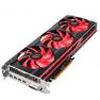Jon Peddie Research released its Q2 2013 GPU market report and interestingly enough if you compare to the previous quarter, AMD shipped 10.9 percent more graphics chips, Intel increased 6.2 percent. NVIDIA However decreased by 8 percent. These numbers include all sorts of graphics product, including dedicated graphics cards and IGPs.
As a result AMD's marketshare now is 21.9 percent, NVIDIA 16.1 percent and the rest is Intel, the chip giant has 62 percent thanks to its enormous amount of processors with integrated graphics.
Jon Peddie Research (JPR), the industry's research and consulting firm for graphics and multimedia, announced estimated graphics chip shipments and suppliers’ market share for 2013 2Q. While the news was disappointing year-to-year, the news was encouraging quarter-to-quarter.
AMD overall unit shipments increased 10.9%, quarter-to-quarter, Intel increased 6.2%, and Nvidia decreased by 8%.
The overall PC market declined 2.5% quarter-to-quarter while the graphics market increased 4.6%. Overall this net 7.1% increase reflects an interest on the part of consumers for double-attach—the adding of a discrete GPU to a system with integrated processor graphics, and to a lesser extent dual AIBs in performance desktop machines.
On a year-to-year basis we found that total graphics shipments during Q2’13 dropped 6.8% while PC shipments which declined by at a faster rate of 11.2% overall. GPUs are traditionally a leading indicator of the market, since a GPU goes into every system before it is shipped and most of the PC vendors are guiding down to flat for Q3’13. The popularity of tablets and the persistent economic slowness are the most often mentioned reasons for the decline in the PC market and the CAGR for PC graphics from 2012 to 2016 is -1.4%; we expect the total shipments of graphics chips in 2016 to be 319 million units. The ten-year average change for graphics shipments for quarter-to-quarter is a growth of 7.2%. This quarter is below the average with a 4.6% increase.
Our findings include discrete and integrated graphics (CPU and chipset) for Desktops, Notebooks (and Netbooks), and PC-based commercial (i.e., POS) and industrial/scientific and embedded. This report does not include handhelds (i.e., mobile phones), x86 Servers or ARM-based Tablets (i.e. iPad and Android-based Tablets), Smartbooks, or ARM-based Servers. It does include x86-based tablets.
The quarter in general
- AMD’s shipments of desktop heterogeneous GPU/CPUs, i.e., APUs declined 9.6% from Q1 and increased an astounding 47.1% in notebooks. The company’s overall PC graphics shipments increased 10.9%.
- Intel’s desktop processor-graphics EPG shipments decreased from last quarter by 1.4%, and Notebooks increased by 12.13%. The company’s overall PC graphics shipments increased 6.2%.
- Nvidia’s desktop discrete shipments were down 8.9% from last quarter; and, the company’s mobile discrete shipments decreased 7.1%. The company’s overall PC graphics shipments declined 8.0%.
- Year-to-year this quarter AMD overall PC shipments declined 15.8%, Intel dropped 12.9%, Nvidia declined 5.1%, and VIA fell 12.4% from last year.
- Total discrete GPUs (desktop and notebook) were down 5.5% from the last quarter and were down 5.2% from last year for the same quarter due to the same problems plaguing the overall PC industry. Overall the trend for discrete GPUs is up with a CAGR to 2016 of -2.2%.
- Ninety nine percent of Intel’s non-server processors have graphics, and over 67% of AMD’s non-server processors contain integrated graphics; AMD still ships IGPs.
Year-to-year for the quarter the graphics market decreased. Shipments were down 16.1 million units from this quarter last year.
Graphics chips (GPUs) and chips with graphics (IGPs, APUs, and EPGs) are a leading indicator for the PC market. At least one and often two GPUs are present in every PC shipped. It can take the form of a discrete chip, a GPU integrated in the chipset or embedded in the CPU. The average has grown from 1.2 GPUs per PC in 2001 to almost 1.4 GPUs per PC.


